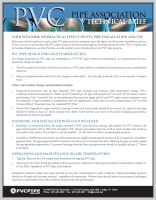|
Cold Weather Has No Practical Effect
on PVC Pipe Installation and Use
Negative attacks made by our competitors allege that PVC pipe is not suitable
for cold-weather projects. The attached technical brief refutes this claim.
PVC pipe has been in service in North America since the 1950s and has proven its
ability to function well when exposed to the rigors of cold-temperature
installation and operation. PVC is widely used in Canada, Minnesota, and the
Dakotas, so cold weather is not a limiting factor for PVC pipe projects.
In fact, installation of PVC pipe is even more advantageous as temperatures
decrease and workers become hampered by inclement weather conditions. PVC is
ideal in these situations because it is easy to cut, easy to handle, and easy to
assemble.
This technical brief discusses
three aspects of PVC pipe in cold temperatures:
-
Design

● Effects on PVC's material properties
● Accommodating thermal expansion
● How to prevent freezing
-
Handling and Installation
●
Effects on PVC's material properties
●
Accommodating thermal expansion
●
How to prevent freezing
-
Operations - no change from typical operations
There are three key messages:
-
In cold conditions, installation practices are important
for all piping - abusive handling practices should not be used with any pipe
material.
-
Worker safety should always be paramount - prolonged
exposure to cold temperatures may affect workers' productivity and performance.
-
PVC pipe is a logical choice for cold-weather projects.
For the Tech Brief,
click here.
|
Regards,
|
|

|
|
John F. Houle, P.E.
Senior Technical Consultant, PVC Pipe Industry
201 E. John Carpenter Freeway, Suite 750 | Irving, TX 75062
T. 972.243.3902 | F. 972.243.3907
www.uni-bell.org
  
|
|